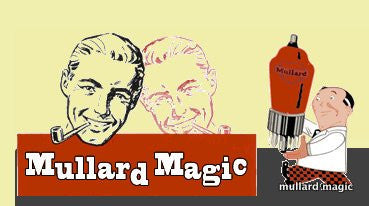THE GREAT MULLARD MAGIC BLOG — VALVE TESTING
MULLARD FACTORY DYNAMIC VALVE TESTING
Posted by STEVE M on
Valves as we know, have many different functions and for each application there are certain parameters which ensure the best use in these applications, for example: - For an audio amplifier - knowledge of the maximal power output and distortion of an output valve for various levels of signal input under variable anode load resistance and grid load resistance is important. For a radio receiver - knowledge of the cross-modulation factor allows effective choice of frequency changer valves and IF amplifier valves so that effective AGC circuits may be designed. In order to measure these parameters and others such as equivalent noise resistance, hum level, conversion...
- Tags: MULLARD, VALVE TESTING
MULLARD FACTORY PRODUCTION VALVE TESTING
Posted by STEVE MYCIUNKA on
The Mullard valve factories had numerous test schedules for valves produced but today, we are going to look at the production test that EVERY valve that went into stock received which was known colloquially throughout the Mullard organisation at ' Test I'. It is interesting to note that, with the exception of the knock test, the test schedule is identical to that used by Mullard Magic before any of our valves go on sale. The Test I schedule was conducted by two girls, however, by mid 1953, for some popular valve types, Test I was automated meaning that...
- Tags: MULLARD, VALVE TESTING
VALVE TYPES & MANUFACTURING TECHNIQUES (xxi) - B7G & B9A VALVE ASSEMBLY - TEST 1, FINAL TESTS
Posted by STEVE MYCIUNKA on
After passing the knock test, valves were passed to the main test bench and plugged into a test board where a specially designed eight position switch applied successively, appropriate voltages such that values were obtained for the following parameters: - Heater current Cathode current Control grid current Screen current Anode current Total emission Mutual conductance ( at 4 - 7 points on the characteristic curve dependant on valve type) Inter electrode insulation for all electrode combinations Only those valves whose performance fell within specified limits were then passed into "Factory Stock." In the photograph below we see Enid Barribal testing...
VALVE TYPES & MANUFACTURING TECHNIQUES (xix) - B7G & B9A VALVE ASSEMBLY - AGEING
Posted by STEVE MYCIUNKA on
And so the story continues.......... a couple of blog entries ago, we left the production process at the sealing stage at which point we had a sealed and functioning valve, however, further processing was required before it was suitable for use for it was required to undergo a process called ageing. Ageing consisted of operating the valve under load under carefully controlled conditions. Large numbers of valves were plugged into a socket rack like the one in the photo below: - Once the rack was fully loaded, the valve heaters were activated at a 20% higher than nominal rating, so...
- Tags: MULLARD, VALVE AGEING, VALVE TESTING
MULLARD FACTORY QUALITY CONTROL TESTING
Posted by STEVE M on
As well as the production testing we discussed in a recent blog entry, Mullard employed Quality Control (QC) testing where a sample of ten valves were taken at regular intervals and subjected to a range of tests. These tests differed from the production tests which were go/no-go type in that the QC tests were quantitative and the results were recorded using a series of Shewart Charts to individually log test characteristics both within a single batch and also inter batch. The Shewart Chart is a time related plot which allowed trends in measurement to be monitored. The chart would have...
- Tags: ', mullard, valve testing






